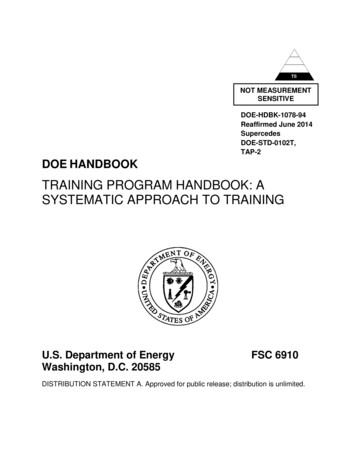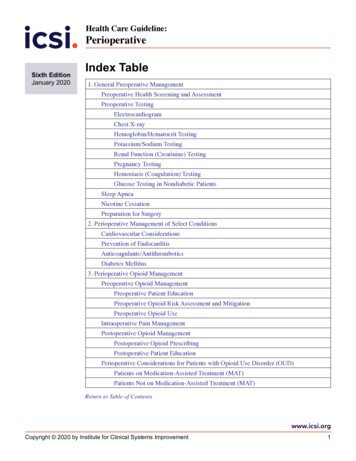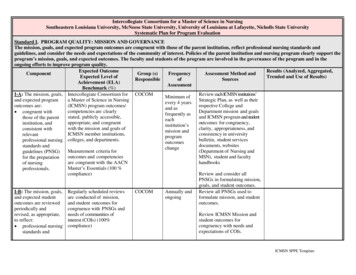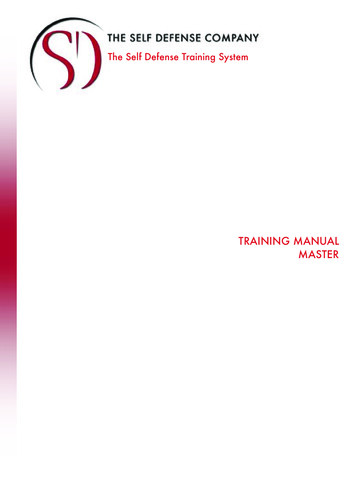
Transcription
NOT MEASUREMENTSENSITIVEDOE-HDBK-1078-94Reaffirmed June 2014SupercedesDOE-STD-0102T,TAP-2DOE HANDBOOKTRAINING PROGRAM HANDBOOK: ASYSTEMATIC APPROACH TO TRAININGU.S. Department of EnergyWashington, D.C. 20585FSC 6910DISTRIBUTION STATEMENT A. Approved for public release; distribution is unlimited.
This document has been reproduced directly from the best available copy.Available to DOE and DOE contractors from the Office of Scientific andTechnical Information, P.O. Box 62, Oak Ridge, TN 37831; (615)576-8401.Available to the public from the U.S. Department of Commerce, TechnologyAdministration, National Technical Information Service, Springfield, VA 22161;(703)487-4650.Order No. DE94018722
DOE HDBK-1078-94ErrataJune 2014Table of ChangesPage/SectionPage vii/1st paragraphPage vii/4th paragraphPage 1/Section1.0Page 6/Section 2.1.3Page 6/Section 2.1.5Page 17/Section 3.1Page 17/Section3.1.1Page 17/Section 3.1.1.1Page 20/Section 3.1.2Page 20/Section 3.1.2ChangeDOE O 426.2, Personnel Selection,Training, Qualification, and CertificationRequirements for DOE Nuclear Facilitiesand DOE O 426.1, Federal TechnicalCapability. This Handbook contains norequirements.Brendan M. Burns, PE HS32, FORS 1F-045U.S. Department of EnergyWashington, D. C. 20585Phone (202) 586-2671Facsimile (202) 586-3915This commitment should be made by seniormanagement from the beginning.Managementshould An effective needs analysis involves subjectmatter experts (SMEs)Any actions taken and decisions made duringthe needs analysis should be documented.Care should be taken when developing andwriting learning objectives. Trainees eitherclearly understand them, or they are oflimited use. Related terminal objectives arethen written When writing a terminal objective, considerthe training setting since it has to be balancedagainst available resources and facilityconstraints.However, feedback should be provided.All terminal objectives for tasks identifiedfor inclusion in the training program shouldnow be sequencedThey should be sequenced in a logicalprogression which takes into account thelevel of learning necessary to build to the
Table of Changesnext objective.Page 22/Section 6.Page 22/Section 3.2.1Page 23/Section 3.2.1Page 23/Section .3.2.4Page 24/Section 3.2.5Page 25/Section 3.2.6page 25/Section 3.2.7Page 26/Section 3.3.2Page 26/Section 3.3.3Page 26/Section 3.4Page 29/Section 3.5.4Page 37/Section 4.3.1Page 46/Section 5.1.3Page 54/Section 6.1.2.1.Page 60/Section 6.2Page 60/Section 6.2List of qualifications, courses of instruction,etc., that have to be completed prior toadministration of the performance testThe testing reflects the stated terminalobjective.Key portions of a task should be "perform"items whenever existing facility conditionspermit. the entry-level KSAs of the trainee shouldbe considered.Although a compromise, the conditions andstandards applied during training and testingshould be designed to be the Any identified KSAs that are not included inthe entry-level requirements should beincorporated into an enabling objective.scorable items should be clearly defined todistinguish between satisfactory andunsatisfactory performance.Although at least one test item should bedeveloped for each learning objective, Test items should have answer keys writtenat this time.tests are needed prior to implementing thetraining program.DOE-HDBK-1001-96Each learning activity should be analyzed to by identifying a clear indication of whatwill be learned Identify all actions or key points to beevaluated. Each should be important,observable, and measurable;Program evaluation information should beanalyzed before it is used to make changes intraining.Verify apparent performance discrepanciesthrough discussions
DOE-HDBK-1078-94Table of ContentsFOREWORD . ivACRONYMS . ix1.1 INTRODUCTION . 11.2Development of this Handbook . 11.3Handbook Description . 11.4Management of the Training Program . 32.1 ANALYSIS . 52.2Determine Training Needs . 52.3Develop a Valid Task List . 72.4Select Tasks for Training . 112.5Prepare a Task-to-Training Matrix . 132.6Conduct an Analysis of Existing Training Material . 132.7Conduct a Task Analysis . 142.8Application of Job or Task Analysis Information . 152.9Training Development/Changes . 152.10 Analysis Checklist . 152.11Key Considerations. 153.1 DESIGN . 173.2Write Terminal Objectives . 173.3Develop Training/Evaluation Standards (TESs). 203.4Develop Test Items . 253.5Construct Tests . 263
DOE-HDBK-1078-943.6Write Training Development and Administrative Guide . 283.7Key Considerations . 314.1 DEVELOPMENT . 334.2Select Training Methods . 334.3Develop Lesson Plans . 334.4Develop Training Support Material . 364.5Conduct Training Tryouts . 394.6Key Considerations . 435.1 IMPLEMENTATION . 455.2Conduct Training . 455.3Conduct In-Training Evaluation . 485.4Document Training . 495.5Key Considerations . 516.1 EVALUATION. 536.2Monitor Indicators . 536.3Analyze Information . 606.4Initiate Corrective Actions . 626.5Key Considerations . 62ATTACHMENTSAttachment 1 Training Needs Analysis Report. 67Attachment 2 Guidelines for Writing Task Statements. 68Attachment 3 Task Rating System . 69Attachment 4 Sample Survey Questionnaire . 70Attachment 5 Job Analysis Tabulation . 82Attachment 6 Task-to-Training Matrix . 83Attachment 7 Task Analysis Data Collection Form . 84Attachment 8 Task Worksheet . 854
DOE-HDBK-1078-94Attachment 9 Training Development/Change Request . 86Attachment 10 Analysis Checklist . 87Attachment 11 Guidelines for Writing Learning Objectives. 88Attachment 12 Sample Training Evaluation Standard (TES) . 104Attachment 13 Training Evaluation Standards (TESs) Development Worksheet . 107Attachment 14 Training Evaluation Standards (TESs) Review Checklist. 109Attachment 15 Completed TES Development Worksheet . 110Attachment 16 Test Item Formats . 113Attachment 17 Sample Test Specification Form for 50-Item General EmployeeTest . 116Attachment 18 Sample Training Development and Administrative Guide. 117Attachment 19 Training Methods . 126Attachment 20 Sample Lesson Plan Format—Classroom . 129Attachment 21 Sample Lesson Plan Format—OJT . 131Attachment 22 Sample Lesson Plan Format—Simulator. 137Attachment 23 Training Materials Historical Record . 150Attachment 24 Instructor Activities . 151Attachment 25 Lesson Plan Checklist . 153Attachment 26 Training Media . 155Attachment 27 Learning Activity Characteristics . 160Attachment 28 Existing Material Review Criteria . 161Attachment 29 Sample Instructor Evaluation Form. 162Attachment 30 Instructor Supervisor Evaluation Example . 164Attachment 31 Indicators of Potential Program Weaknesses . 165Attachment 32 Posttraining Questionnaire . 166Attachment 33 Posttraining Interview . 168Attachment 34 Instructor Lesson Rating Form . 169Attachment 35 Sample Course Critique . 171Attachment 3 6 Example Employee Training Evaluation . 172Attachment 37 Revision Critique Summary . 173Attachment 38 Lesson Plan Review Criteria Checklist . 174Attachment 39 Instructor Observation Checklist—Classroom . 176Attachment 40 Training Development Recommendation Checklist . 180Attachment 41 Laboratory Instructor Evaluation. 182Attachment 42 Instructor Performance Assessment Instrument . 185Attachment 43 Supervisor's Posttraining Feedback . 188Attachment 44 Simulator Instructor Observation . 189Attachment 45 Trainee Posttraining Evaluation . 191Attachment 46 Trainee Cumulative Feedback Evaluation . 1945
DOE-HDBK-1078-94Attachment 47 End-of-Course Training Evaluation . 196Attachment 48 Program Evaluation . 198FIGURESFigure-1 Criteria for Selecting Tasks for Training. 126
DOE-HDBK-1078-94FOREWORDThis Department of Energy (DOE) Handbook, DOE-HDBK-1 078-94, Training ProgramHandbook: A Systematic Approach to Training, describes a systematic method for establishingand maintaining training programs that meet the requirements and expectations of DOE OrdersDOE O 426.2, Personnel Selection, Training, Qualification, and Certification Requirements forDOE Nuclear Facilities and DOE O 426.1, Federal Technical Capability. This Handbookcontains no requirements. The systematic approach to training (SAT) includes five distinct, yetinterrelated, phases. These phases include analysis, design, development, implementation, andevaluation. SAT is consistent with other systematically based training systems such asperformance-based training (PBT), training system development (TSD), instructional systemsdevelopment (ISD), and other similar methods. For the purposes of this Handbook, SAT andPBT are interchangeable. The systematic approach method may also be used in conjunction withother DOE orders and directives that contain personnel training and qualification requirements.This Handbook describes the more classical concept and approach to systematically establishingtraining programs. However, in some cases this classical approach has proven to be time- andlabor-intensive, especially if excessive detail is expected. The risk and complexity associatedwith performance of a job or the nuclear hazard category of the facility affected may warrant theuse of simpler, less detailed alternative methods to achieve results that are both satisfactory andeffective. These methods are discussed in other Departmental and industry standards.Users of this Handbook should consider the variety of training options that are available forestablishing and maintaining personnel training and qualification programs. Blending classicaland alternative systematic approaches to training methods often yields the most effectiveproduct. Finally, users should emphasize the fundamental goal of any training program as theyuse this Handbook; that is, to prepare workers to do their jobs safely, efficiently, and effectively,and to protect the work force, the public, and the environment.Beneficial comments (recommendations, additions, deletions) and any pertinent data that may beof use in improving this document should be addressed to:Brendan M. Burns, PEHS-32, FORS 1F-045U.S. Department of EnergyWashington, D. C. 20585Phone (202) 586-2671Facsimile (202) 586-3915by using the U.S. Department of Energy Standardization Document Improvement Proposal(DOEF 1300.X) appearing at the end of this document or by letter.vii
DOE-HDBK-1078-94This Handbook replaces DOE-STD-0102T, "TAP 2 Performance-Based Training Manual," ofAugust 1993.viii
DOE-HDBK-1078-94ACRONYMSDOEDepartment of EnergyECCSEmergency Core Cooling SystemECSEmergency Cooling SystemEOLEnd of LifeHPHealth PhysicsKSAKnowledge, skill, and abilityNE-1Assistant Secretary for Nuclear EnergyOJTOn-the-job trainingOROccurrence ReportOSHAOccupational Safety and Health ActP&EPlant and EquipmentPERPerformance Evaluation ReportSDStanding DirectivesSERSafety Evaluation ReportSMESubject matter expertSOPStandard Operating ProcedureSPStandard PracticeTAPTraining Accreditation ProgramTESTraining/Evaluation StandardTSTechnical Specifications (“Tech Specs”)ix
DOE-HDBK-1078-94TRAINING PROGRAM HANDBOOK: A SYSTEMATICAPPROACH TO TRAINING1.1 INTRODUCTIONThe cornerstone of safe operation of the Department of Energy (DOE) nuclear facilities ispersonnel performing the day-to-day functions which accomplish the facility mission. Trainingthat is conducted efficiently and effectively and is directly related to the needs of the job (i.e.,performance-based training) is fundamental to safe operation. Responsibility for thesafeoperation of these facilities is a line-management function. Therefore, achievingperformancebased training requires commitment from the organization for which training isprovided. Thiscommitment includes making subject matter experts (SMEs) available forparticipation in andreview of the products of the performance-based training process. It alsoincludes budgeting andscheduling the time required for both initial and continuing training. This commitment should bemade by senior management from the beginning. Managementshould get involved at the start toensure that they are not only cognizant of ongoing activitiesbut are also involved to the degreenecessary to thoroughly understand the process. Policiesimplemented and support demonstratedby senior management provide the driving force toensure that training programs receive theattention that is imperative, if facility trainingprograms are to be successful.1.2Development of this HandbookThis Handbook has been designed to assist facilities/sites/offices in their efforts todevelop training programs based on the systematic approach to training (SAT) model.Information in this Handbook has been compiled from a number of sources: TheInstituteof Nuclear Power Operations, Principles of Training System Development;DOEGuidelines for Job and Task Analysis for Department of Energy NuclearFacilities; andselected DOE contractor training manuals and procedures. In addition,personnelrepresenting DOE contractors and private industry contributed significantlyto thedevelopment of this process.1.3Handbook DescriptionThis Handbook contains a narrative discussion on the various phases of the systematicapproach to training process. The phases can be modified and incorporated asappropriatewhen developing detailed local procedures. Each phase is organized suchthat the majorsteps necessary to adequately complete it are clear. Figures, attachments,and illustrationsare added for clarification and may be reproduced as desired.The processes described in this Handbook represent only one of the possible approachesfor the development of training programs using the systematic approach to trainingmodel. Other approaches may work equally well if they are based on a systematic method1
DOE-HDBK-1078-94of determining and implementing training that is directly related to the needs andrequirements of the job.This Handbook was written on the assumption that a facility/site/office is currentlynotusing the systematic approach to training model for their training programs. However,many facilities/sites/offices do have effective training programs in placethat containmany performance-based characteristics. Existing programs should notbe discarded,rather systematic methods should be used to validate and supplementthe content wherenecessary. The systematic approach also helps refine the methodsof managing andimplementing these programs.This Handbook is organized into a series of sections, each section representing one ofthephases of the SAT model. An overview of each of the phases follows.1.3.1Analysis. This section addresses three methods of identifying training/performance requirements: needs analysis, job analysis, and task analysis. Themajor outputs of the analysis phases are a task list for each position, and a task-totraining matrix.The task-to-training matrix identifies the training disposition of the tasksidentifiedin the task list and lists the existing materials that support taskperformance.Participation of subject matter experts and facility personnel isemphasizedthroughout the processes.1.3.2Design. The design phase uses the information collected during the analysis phaseto provide a “blueprint” for developing training programs based upon the SATmodel. This section of the Handbook addresses methods for writinglearningobjectives, setting training standards, designing tests, and preparingtraining plans.The major outputs of the design phase are learning objectivesand test items. Forexisting programs, contractors are encouraged todetermine if their learningobjectives are appropriate, cover all requiredcontent, and include appropriatecriteria and conditions.1.3.3Development. Development incorporates the results of the design activities. Themajor outputs of the development phase are the completed lesson plans andtraining aids.1.3.4Implementation. Implementation encompasses taking the results of thedevelopment phase into the training setting and conducting the training. Themajoroutput of the implementation phase is trained personnel.1.3.5Evaluation. Evaluation consists of a periodic review of the training materialsandmethods of soliciting feedback from former trainees and their supervisors ontheeffectiveness of training. The major outputs of evaluation are the decisionsmadeto improve the training program during all phases.2
DOE-HDBK-1078-941.4Management of the Training ProgramThis Handbook does not contain all the material or information necessary to make atraining program work. Overall policies and procedures that each organizationdeterminesnecessary to develop and administer performance-based training programs are alsorequired. These policies and procedures may be called Training ProgramManuals,Training Procedures Manuals, Training Management Manuals, TrainingPlans, etc.Whatever its name, the document should contain procedures that govern theway thefacility/site/office conducts training. For purposes of discussion in thisHandbook, thisdocument will be referred to as the Training Management Manual.1.4.1The Training Management Manual should formalize facility policies andprocedures for training. Examples of sections that should be included in themanual follow.1.Introduction and Organization Purpose and scope of the manual; Manual compliance requirements; Training program purpose and goals; and Organizational relationships and reporting structure.2.Qualification and Training Program Descriptions 3.Overview of qualification and training programs;New employee orientation or indoctrination;Visitor indoctrination;Subcontractor indoctrination and training;Descriptions of all training programs (individually or by groups);Instructor training and qualification;Continuing training;Proficiency requirements; andRequalification (periodic, following disqualification, lapsedqualification, etc.).Training Program Material Development and Administration Training/Evaluation Standards;Checklists or qualification cards;Lesson plans, on-the-job-training (OJT) guides, lab guides, etc.;andTraining aids and reference material.3
DOE-HDBK-1078-944.Training Program Standards and Policies 5.Academic standards;Examinations;OJT (conduct and evaluation);Lectures, seminars, training exercises, etc.;Drills;Signature requirements;Student conduct and controls;Disqualification procedures and policies; andExceptions, extensions, and waivers.Administration Training and qualification records;Selection and qualification of instructors;Training program development/change requests;Audits (internal and external);Evaluating training program effectiveness; andControl of subcontracted training.4
DOE-HDBK-1078-942.1 ANALYSISThe process descriptions contained in this section describe a systematic approach to identifyingand documenting performance-based training requirements. The types of analysis used foridentifying training requirements include needs analysis, job analysis, and task analysis. Theseanalyses will provide assurance that training is the appropriate solution to performance problemsand identify requirements that serve as the basis for the design and development of performancebased training programs. The process descriptions in this section will assist users:2.2Determine Training NeedsTraining needs are initially identified by reviewing regulatory requirements and existingtraining programs, and/or conducting a needs analysis. These activities enablefacilities/sites/offices to determine training needs originating from performanceproblems, regulatory requirements, and in some cases, requests for additional training orchanges to existing training.2.2.1Further in-depth analysis need not be conducted for training requirementsoriginating from a regulatory source [DOE Order, Occupational Safety andHealth Act (OSHA), etc.], since in essence the needs analysis has already beendone. These requirements are simply included and addressed in the design anddevelopment phases of the training program. Likewise, additional detailed needsanalyses are not necessary for training programs that are in place and areproducing the desired results. However, needs analyses are appropriate when adiscrepancy exists in the performance of the job. A needs analysis should also beperformed whenever changes to training or requests for new training courses arereceived. The analysis provides assurance that training is appropriate and ensuresthat it is not included elsewhere in the training program.2.2.2A needs analysis can identify solutions to job performance discrepancies.Substandard performance may be related to faulty equipment, inadequateprocedures, attitude of the workforce, etc. Prior to developing new courses ormodifying existing training programs, a needs analysis should be conducted todetermine that training is the appropriate solution. Proper conduct of the analysisidentifies the root cause(s) and serves as a basis for future plans to correctidentified performance discrepancies. The following questions should beevaluated as part of this analysis.1.Do performance deficiencies exist?2.Are employees capable of performing their jobs?3.Do they perform the job frequently?5
DOE-HDBK-1078-942.2.32.2.42.2.54.Have previous employees been able to perform these jobs?5.Are operating procedures adequate or have they changed significantly?6.Are identified deficiencies training-related?An effective needs analysis involves subject matter experts (SMEs) such as jobincumbents and supervisors who are knowledgeable of the job requirements andstandards of performance. Job data collected from these sources provide insightinto performance problems and valuable input into actions planned to correctthem. Analysis of performance problems should follow a logical sequence andcontinue until the root cause is established. In general, the following sequenceshould be followed.1.Identify specific symptoms of the problem clearly.2.List possible alternative causes to the problem.3.Investigate each alternative cause until it can be eliminated or confirmedas a contributor.Circumstances generally having training-related implications may include thefollowing.1.Performance-based training programs for key positions are not in place.2.The facility has a shortage of qualified personnel.3.Major changes in job scope have occurred.4.Changes to requirements have occurred.5.Plant or equipment modifications are not routinely incorporated intotraining programs.Any actions taken and decisions made during the needs analysis should bedocumented. This documentation provides an important element that supports andvalidates the training program since a critical part of the training program recordsis the r
develop training programs based on the systematic approach to training (SAT) model. Information in this Handbook has been compiled from a number of sources: TheInstitute of Nuclear Power Operations, Principles of Training System Development;DOE Guidelines for Job and Task










